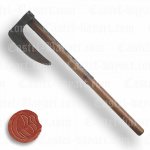Joel Spanky Gray
First Post
So here is a more complex AC calculation method that I've used for a few months. For anyone that has ever sparred with hand weapons you know that being armed with any medium length hand weapon increases your defense, and that shields are underrated, but lose a little of their effectiveness when wearing heavy armor. So here is an AC patch you can use, and please feel free to make some suggestions on how I could make it even better.
First, I split AC into Melee AC and Ranged AC.
MELEE AC = 8 + Mobility bonus + Armor bonus
Mobility bonus = [Dexterity modifier + Proficiency bonus]/2, round up.
- Monks add their Wisdom modifier to their mobility bonus.
Armor Bonus = Take the highest bonus as a base, then add 1/2 of the other bonuses (round up).
- Armor bonus is 1 (thick clothes), 2 (padded/leather), 3 (hide, studded leather), 4 (scale, chain), 5 (brigandine, heavy chain, light plate), 6 (plate), 7 (heavy plate).
- Shield bonus is 2 (small), 4 (medium), 6 (large).
- Weapon bonus is 0 (short - dagger, short club), 1 (most one-handed weapons), 2 (most two-handed weapons), 3 (reach weapons like polearms and long spears)
- Barbarians use their Constitution modifier instead of Armor bonus if it is higher.
RANGED AC = 8 + Mobility bonus + Armor bonus
- The same as Melee AC, but do not use weapon bonus. Ranged AC tends to be a little lower than Melee AC.
I never bothered with distinguishing light/medium/heavy armor. That is completely relative to Strength. Although I do use the disadvantage on Stealth part. I only recalculate the AC of humanoid monsters that use weapons, shields, and armor.
First, I split AC into Melee AC and Ranged AC.
MELEE AC = 8 + Mobility bonus + Armor bonus
Mobility bonus = [Dexterity modifier + Proficiency bonus]/2, round up.
- Monks add their Wisdom modifier to their mobility bonus.
Armor Bonus = Take the highest bonus as a base, then add 1/2 of the other bonuses (round up).
- Armor bonus is 1 (thick clothes), 2 (padded/leather), 3 (hide, studded leather), 4 (scale, chain), 5 (brigandine, heavy chain, light plate), 6 (plate), 7 (heavy plate).
- Shield bonus is 2 (small), 4 (medium), 6 (large).
- Weapon bonus is 0 (short - dagger, short club), 1 (most one-handed weapons), 2 (most two-handed weapons), 3 (reach weapons like polearms and long spears)
- Barbarians use their Constitution modifier instead of Armor bonus if it is higher.
RANGED AC = 8 + Mobility bonus + Armor bonus
- The same as Melee AC, but do not use weapon bonus. Ranged AC tends to be a little lower than Melee AC.
I never bothered with distinguishing light/medium/heavy armor. That is completely relative to Strength. Although I do use the disadvantage on Stealth part. I only recalculate the AC of humanoid monsters that use weapons, shields, and armor.

